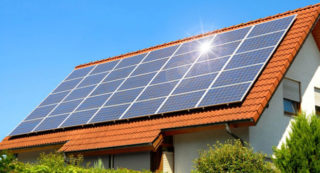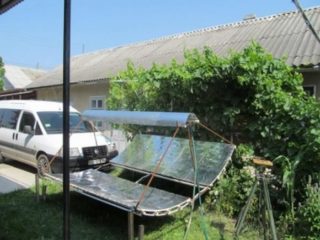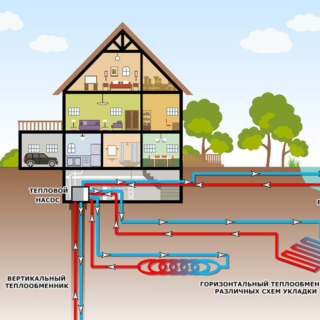Alternative heating of a private dwelling makes it possible to obtain heat from natural sources with minimizing the environmental load on the environment. The massive use of renewable natural energy sources contributes to a more economical use of natural resources. The rise in price of gas and electricity prices also encourages residents to look for alternatives that would not have to pay bills.
Alternative heating definition
Alternative sources of heating for a private home include the types of heat supply systems that use natural energy sources. At the same time, the costs of installation of such installations should be affordable and not comparable with the cost of serviced housing. Such schemes are used, as a rule, in country houses. For residents of multi-apartment complexes, the question is not raised, since each apartment is connected to central heating.
Interest in alternative heating sources is associated with a steady increase in prices for most common energy sources. This also applies to the cheapest option - district heating. Due to limited natural resources, this trend will be observed in the future, which forces us to look for new sources of energy. In addition to economic benefits, such methods of heating a house are good because the atmosphere is not polluted by the solid and gaseous emissions obtained by burning different types of fuel. This helps to improve the environmental situation.
Varieties of alternative heating
Ways to heat a house without connecting to main energy carriers can be classified based on which source is used to generate heat. They differ in the design of the installation and the restrictions imposed.
Biomass energy
This method is most common for most consumers. This includes such forms of solid fuels as sawdust (and pellets from them), wood waste, straw, hay, and other by-products of agricultural agriculture.
In order to receive heat from burning such raw materials, in some cases it will not even be necessary to fundamentally rebuild the heating system. When using a solid fuel or combined boiler or furnace capable of absorbing such fuel, nothing needs to be done. If the heating unit cannot work with biomass, it is dismantled and a suitable one is installed in its place. A compact and easy to install option is a metal furnace. Also, special heat generators with automation working on granules and pellets of biomass are suitable.
There are also facilities for processing agricultural waste and animal livelihoods into gas fuel. Having cleaned it, you can use it to service a conventional gas boiler. The waste remaining after the process is used in the fields for fertilizer.
Solar systems
There are different schemes for heating the house with solar energy. Some are based on turning it into an electric one, which serves for the operation of heating devices. In others, a heat carrier fluid heated by the sun circulates through convector or radiator elements. The simplest system is based on the use of a collector device and a pump that provides water movement.
The following variations of the installation are possible:
- The collector works in parallel with an electric heater. Water temperature is regulated by a sensor. When it falls below a predetermined value, heating elements are involved in heating.
- An inverter device and a battery are installed in the solar battery. In daylight, energy accumulates in it. If you use capacious batteries and large batteries with a large working area, you get an autonomous heating system. The problem is that the service life of the battery cells does not exceed five years, and their price is comparable to the electricity spent in the same time.
- Battery with inverter and controller connected in parallel to the outlet. A mechanical counter is also activated. In the sunny season, when the batteries produce even more electricity than is needed for heating, the device counts kilowatts in the opposite direction. This helps a lot to save resources. An electronic device for this installation will not work - it does not have a reverse stroke.
The method is good with the complete absence of environmental burden and the need to pay for solar energy, as well as saving space in the room (collectors are installed on the roof or in the yard).
In Russia, year-round use of solar systems as the only heating method will be released only in the southern regions. In most of the country, in winter, it is necessary to combine the use of collectors with other types of heating - for example, electric.
Wind energy
Here, the principle of operation is based on the conversion of the mechanical energy of the wind generator into electricity, which is then used to heat the living space. Vane devices are available with a small number of blades (1-2 pairs) and with a large number (up to 24). The mechanisms of the first type require a more intense wind to initiate work (minimum 5-8 m / s), have a high efficiency. Multiblade generators have high material consumption, they operate silently and start up with minimal blowing, but their efficiency is lower. The impellers are large: a 4-kW device can have one with a length of 10 m.
There are carousel generators with blades moving along a circular path. They are launched from the minimum wind, silent, but have a low efficiency. As in the case of solar systems, for the full maintenance of the living space you need a constant presence of the energy factor (wind), so they are best suited for regions with appropriate weather.
Heat pumps
Such devices transfer heat to the home from a source with low potential. The main components are similar to those of refrigerators - compressor, heat exchanger and evaporation unit. The most economical option for the price is an air-to-air split system installed in the heating mode. There are also pumps with a finned heat exchanger blown by a low-speed fan. They use street air masses. The installation cost is low, but in cold weather its effectiveness is reduced. This is explained by the fact that it is harder to take away heat from chilled air.
Soil-water pumps are equipped with a horizontal collector element. They are immersed in soil below the freezing point. The heat taken from her is spent on heating water or transferred to heaters. If there is flowing groundwater in the vicinity of the dwelling, a water-to-water pump can be installed.
Advantages and disadvantages
An indisputable plus of alternative heating of a private house is environmental friendliness. Power plants help conserve natural resources, eliminate or minimize emissions of fuel combustion products into the atmosphere. Due to the lack of open fire and flue gases, maximum safety is provided for the home and its inhabitants.Such forms of heating provide autonomy (or, at a minimum, reduce dependence on mains networks). Another plus - tenants will not need to contact the authorities to obtain the required documents.
Cons are due to the fact that in some cases certain climatic parameters are required to take energy from natural sources, sufficient for full house maintenance.
Basics and principles of alternative heating
The functioning of most of these heating systems is based on the collection of energy resources from one or another natural source (wind, soil, water, sunlight) with its subsequent transformation into electricity used for the operation of heating devices. There are also options that do not use electricity, when heat is transferred to a liquid coolant flowing through radiators (some solar systems and heat pumps). Burning biofuels in an oven or boiler allows you to heat a room without being tied to mains networks.
Alternative heating sources are attractive environmental friendliness and the possibility of autonomous home maintenance. For high-quality heating in the winter, they have to be supplemented with other devices.







